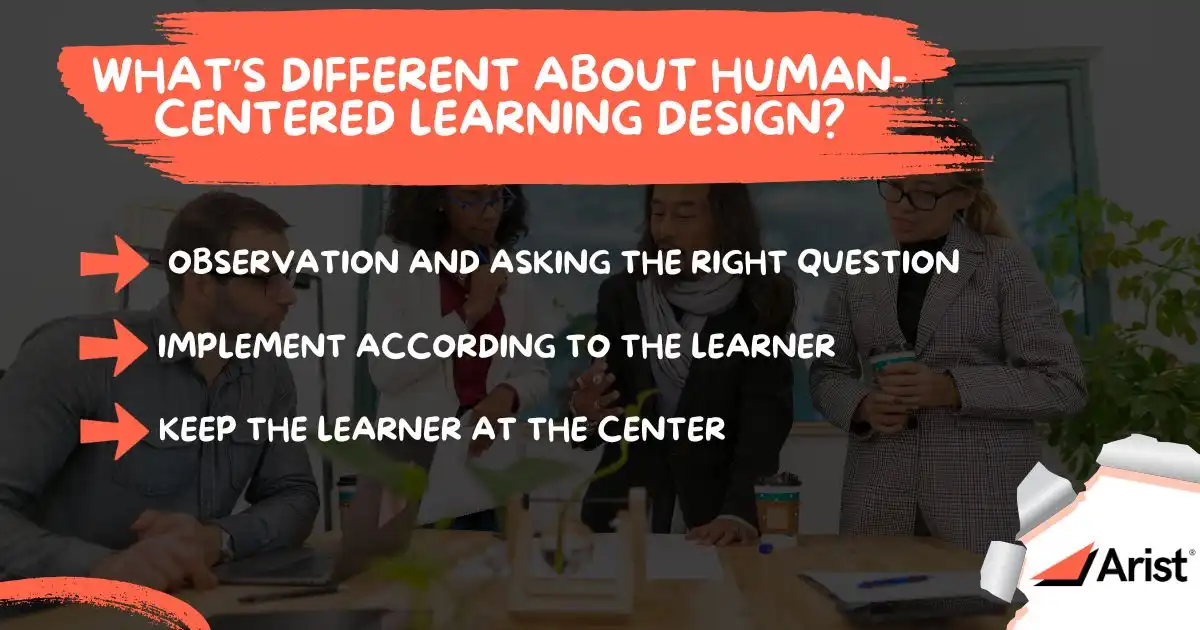How to take a Human-Centered Approach to Learning
The concept of human centered design approach, first popularized by the firm IDEO, has revolutionized product teams around the world. The idea of placing the consumer at the center of the design process sounds simple but has the potential to be groundbreaking. In practice, this approach melds the roles of design, marketing and research to create products and services perfectly suited to their consumers’ needs, wants, habits and struggles.
Human centered design training isn’t just revolutionary for product teams. By taking a user or human-centric approach to your company’s learning strategy, you can quickly transform L&D from a frustrating requirement to a key success factor.
What’s Different about Human-Centric Approach to Learning Design?

Many learning strategies are designed with a goal in mind: optimize learning efficiency, improve team performance, or simply convey necessary information. Once the goal is set, L&D teams tend to move straight to creating content, selecting a learning platform, and pushing courses to learners as quickly as possible. This approach may feel streamlined and efficient, but is missing a key element: the learner.
A human-centered design approach begins with, well, the human. Getting to know your learners on a deeper level is key to finding the perfect learning strategy to help them grow and thrive within your organization. What does your learner’s average work day look like? What do they find most challenging in their role? Which platforms do they interact with on a daily basis?
The answers to these questions will grant you the key to creating a learning strategy perfectly suited to your employees’ needs. Rather than pushing out courses in a one size fits all format, human-centered design allows you to cater to each team's availability and preferences. For example, microlearning may work wonders for your busy sales team, while your designers may learn better from hands-on, gamified content. By meeting your learners with the exact content, format and schedule that works for them, you’ll receive higher learning engagement, better performance results and more positive feedback than ever before.
So how do you get started?
1. Observation and Asking the Right Question
Your human-centered L&D strategy begins by observing your learners. Focus on getting to know each core group of learners separately, as your new hires in need of onboarding may look quite different from your senior management in need of leadership training. Try being a fly on the wall for each learning group’s typical workday. Get to know their objectives, stressors, and roadblocks.
After observation, take the time to ask your learners a few questions. If you know the majority of your learning content will be training focused, ask your learners what they are currently feeling underprepared for. If you’re looking to restructure current content to better suit learners’ needs, ask about how L&D currently fits into their work routine. Allow your learners to guide the conversation, and take thorough notes: this feedback should guide every design choice going forward.
2.Implement according to the Learner
With your notes in hand, it's now time to begin making actual design decisions, starting with deciding what information needs to be taught. Examine your learning group’s daily challenges and stressors: is it due to a lack of training? Team miscommunications? Process bottlenecks? Your course content should directly address an area your learners are lacking in.
When deciding how to convey this content, look for platforms that fit seamlessly into your learner’s schedule and workflow. If your average learner spends 5 hours a day on Zoom meetings, steer clear of long video course formats. Instead, try to select a format that requires minimal time commitment, such as a text-based training course. By providing information in brief messages each day, busy learners will be able to engage with content at a manageable pace. Learn how to design your first Arist course here.
3. Keep the Learner at the Center
The human-centered approach doesn’t end once you have a course in hand. As your learners grow, change and adapt to new challenges in their roles, your L&D strategy should do the same. Provide open communication channels for constant learning feedback on each course, and occasionally circle back to the initial step of observation. Keep your learners engaged and active in the L&D design process by allowing their feedback and ideas to become the catalyst for improved courses. If your learners feel comfortable having a voice in the design process, your human centric approach and human-centric L&D strategy will naturally continue to thrive.
By developing courses that are as flexible, empathetic and collaborative as the humans taking them, you’ll see more impactful learning outcomes than ever before. Not sure how to define and measure your learning outcomes? Check out this helpful article from our VP of Growth, Bianca Nieves.
Maya Gupta
Bring
real impact
to your people
We care about solving meaningful problems and being thought partners first and foremost. Arist is used and loved by the Fortune 500 — and we'd love to support your goals.
Curious to get a demo or free trial? We'd love to chat:


